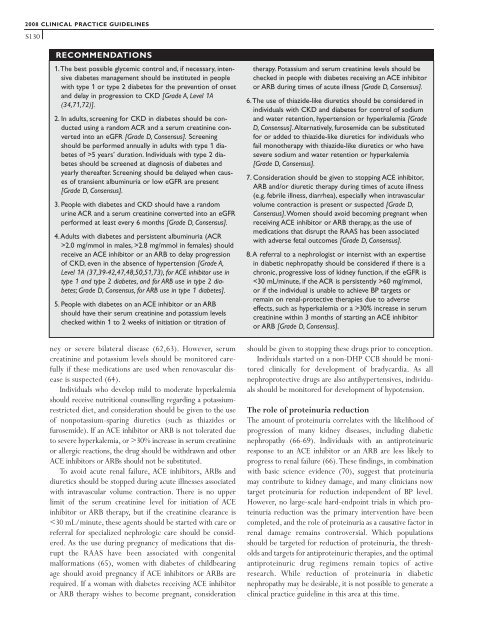2008 Clinical Practice Guidelines - Canadian Diabetes Association
2008 Clinical Practice Guidelines - Canadian Diabetes Association
2008 Clinical Practice Guidelines - Canadian Diabetes Association
You also want an ePaper? Increase the reach of your titles
YUMPU automatically turns print PDFs into web optimized ePapers that Google loves.
<strong>2008</strong> CLINICAL PRACTICE GUIDELINES<br />
S130<br />
RECOMMENDATIONS<br />
1.The best possible glycemic control and, if necessary, intensive<br />
diabetes management should be instituted in people<br />
with type 1 or type 2 diabetes for the prevention of onset<br />
and delay in progression to CKD [Grade A, Level 1A<br />
(34,71,72)].<br />
2. In adults, screening for CKD in diabetes should be conducted<br />
using a random ACR and a serum creatinine converted<br />
into an eGFR [Grade D, Consensus]. Screening<br />
should be performed annually in adults with type 1 diabetes<br />
of >5 years’ duration. Individuals with type 2 diabetes<br />
should be screened at diagnosis of diabetes and<br />
yearly thereafter. Screening should be delayed when causes<br />
of transient albuminuria or low eGFR are present<br />
[Grade D, Consensus].<br />
3. People with diabetes and CKD should have a random<br />
urine ACR and a serum creatinine converted into an eGFR<br />
performed at least every 6 months [Grade D, Consensus].<br />
4.Adults with diabetes and persistent albuminuria (ACR<br />
>2.0 mg/mmol in males, >2.8 mg/mmol in females) should<br />
receive an ACE inhibitor or an ARB to delay progression<br />
of CKD, even in the absence of hypertension [Grade A,<br />
Level 1A (37,39-42,47,48,50,51,73), for ACE inhibitor use in<br />
type 1 and type 2 diabetes, and for ARB use in type 2 diabetes;<br />
Grade D, Consensus, for ARB use in type 1 diabetes].<br />
5. People with diabetes on an ACE inhibitor or an ARB<br />
should have their serum creatinine and potassium levels<br />
checked within 1 to 2 weeks of initiation or titration of<br />
ney or severe bilateral disease (62,63). However, serum<br />
creatinine and potassium levels should be monitored carefully<br />
if these medications are used when renovascular disease<br />
is suspected (64).<br />
Individuals who develop mild to moderate hyperkalemia<br />
should receive nutritional counselling regarding a potassiumrestricted<br />
diet, and consideration should be given to the use<br />
of nonpotassium-sparing diuretics (such as thiazides or<br />
furosemide). If an ACE inhibitor or ARB is not tolerated due<br />
to severe hyperkalemia, or >30% increase in serum creatinine<br />
or allergic reactions, the drug should be withdrawn and other<br />
ACE inhibitors or ARBs should not be substituted.<br />
To avoid acute renal failure, ACE inhibitors, ARBs and<br />
diuretics should be stopped during acute illnesses associated<br />
with intravascular volume contraction. There is no upper<br />
limit of the serum creatinine level for initiation of ACE<br />
inhibitor or ARB therapy, but if the creatinine clearance is<br />
30% increase in serum<br />
creatinine within 3 months of starting an ACE inhibitor<br />
or ARB [Grade D, Consensus].<br />
should be given to stopping these drugs prior to conception.<br />
Individuals started on a non-DHP CCB should be monitored<br />
clinically for development of bradycardia. As all<br />
nephroprotective drugs are also antihypertensives, individuals<br />
should be monitored for development of hypotension.<br />
The role of proteinuria reduction<br />
The amount of proteinuria correlates with the likelihood of<br />
progression of many kidney diseases, including diabetic<br />
nephropathy (66-69). Individuals with an antiproteinuric<br />
response to an ACE inhibitor or an ARB are less likely to<br />
progress to renal failure (66).These findings, in combination<br />
with basic science evidence (70), suggest that proteinuria<br />
may contribute to kidney damage, and many clinicians now<br />
target proteinuria for reduction independent of BP level.<br />
However, no large-scale hard-endpoint trials in which proteinuria<br />
reduction was the primary intervention have been<br />
completed, and the role of proteinuria as a causative factor in<br />
renal damage remains controversial. Which populations<br />
should be targeted for reduction of proteinuria, the thresholds<br />
and targets for antiproteinuric therapies, and the optimal<br />
antiproteinuric drug regimens remain topics of active<br />
research. While reduction of proteinuria in diabetic<br />
nephropathy may be desirable, it is not possible to generate a<br />
clinical practice guideline in this area at this time.











